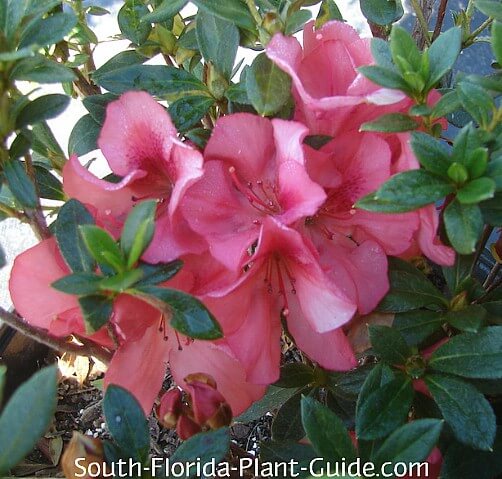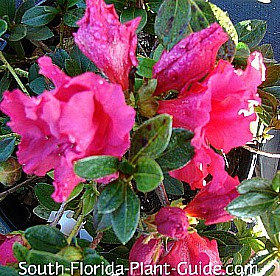Dwarf Azalea
Rhododendron spp.
The beauty of dwarf azaleas is that they bloom on and off all year - even in shadier areas - staying small and manageable.

These azalea bushes can be kept small - 3 feet or less - and grow more slowly than full-size azaleas.
Dwarf shrubs like the popular Red Ruffle azalea work well in almost any kind of light, and are especially appealing in a formal landscape.
The most compact are dwarf azalea varieties that grow 2 to 3 feet. They include:
- Red Ruffle - rose-red flower with ruffled edges
- Madonna White - bright white ruffled blooms
- Variegated Dogwood - pink and white flowers
- Fashion - bright coral-pink blossoms
Semi-dwarf azaleas can grow to 4 feet or more (though you can trim them shorter). They include:
- Duc de Rohan - little leaves like boxwood and bright salmon-pink flowers
- Duchess of Cypress - pale pink blooms
- Little John - burgundy-leafed cultivar with similar colored blossoms (doesn't flower often but foliage is colorful)
Plant specs
A dwarf azalea will grow in full sun to full shade.
If you're going to plant in a sunny area, make sure the nursery you buy from has grown it in - or acclimated it to - full sun. (For tips on acclimating the plant yourself, see Plant Light Requirements.)
Most of these plants prefer part sun to part shade. In full shade an azalea will grow leggy with fewer leaves, though it will flower.
Azaleas are evergreen, and the dwarf and semi-dwarf varieties are slow to moderate growers.
Very cold hardy anywhere in Florida, they do best in Zone 9B and inland areas of Zone 10A.

If you live near the beach, don't plant azaleas. They will not grow in coastal areas because the soil is too alkaline.
The heaviest bloom usually happens between February and April, with occasional flowers throughout the rest of the year.
Depending on variety, a dwarf azalea can be kept 2 to 3 feet tall.
Plant care
Azalea care is a bit more involved than most.
When planting azaleas, cut an X across the bottom of the root ball and very gently loosen the roots. These plants have fibrous roots that won't always spread out on their own.
Use Canadian sphagnum peat moss when you plant. Add it to the hole and then fill the hole with water. Squish the moss with your hands to make it absorb the moisture. Canadian peat helps the plant's root ball retain moisture and it also lowers the pH.

An azalea bush needs acidic soil to flourish. Planting with Canadian peat moss will help.
But if you're planting a large bed of azaleas, you might want to have your soil tested first before investing in a lot of plants.
Azaleas prefer a pH of 5.5 or less. You can treat the soil with sulfur (or certain sulfates) to lower the pH, at least temporarily. Consult your local plant nursery for a soil-acidifier product recommendation.
Avoid
using these plants in coastal areas, where the soil is very alkaline, or
near concrete that can leach into the soil and turn it too alkaline.
Regular
watering is a must. You can help keep your azaleas from going too dry
between waterings by planting with water retention crystals. (See the
page on Watering for more info.)
Mulch around the shrub to help keep roots moist, but keep the mulch at least 6 inches away from the plant's base.
Fertilize after the spring bloom with a granular azalea fertilizer. Apply fertilizer again in late summer or early fall.
DO NOT FERTILIZE AFTER OCTOBER 1st - flower buds will fall off before opening.
For
supplemental feedings between October and spring (or if the leaves are
yellowing), apply essential minor elements (EME) to keep your azaleas
green and happy.
Prune lightly after flowering in spring and trim
to shape anytime. Because they're smaller overall and grow at a slower
rate than larger varieties, you won't have to do a hard pruning.
Plant spacing
Place small azaleas 2 feet apart.
Avoid planting too near concrete foundations, walks and drives...space the shrub at least 3 feet away.
These plants can be grown in containers but do best in the ground.
Landscape uses for dwarf azalea
- small shrub for front of the border
- lining a low wooden fence
- accent plant or group plantings for a garden bed
- around the trunk of a tree or palm
- along a walkway
- surrounding a mailbox or lamppost
GOOD SNOWBIRD PLANT? YES (with regular irrigation)
COMPANION PLANT SUGGESTIONS: In a partially shaded location, use chenille plant, firespike, downy jasmine, heliconia, peace lily, dracaena and cordyline, golden shrimp plant, and star jasmine.
Other shrubs you might like: Azalea (full size), Dwarf Tibouchina
Take a break!
The ultimate guide to low-maintenance plants
and landscaping!
An ebook by
Chase Landre
author of
South-Florida-Plant-Guide.com
Learn more!
Get a greener thumb!
Want to learn more about South Florida planting, watering, fertilizing and dealing with weeds and pests?
See our Gardening How-To section for answers!
Get instant curb appeal!
An ebook by
Chase Landre
author of
South-Florida-Plant-Guide.com
Learn how to get instant curb appeal with fast growing plants and landscaping techniques!


